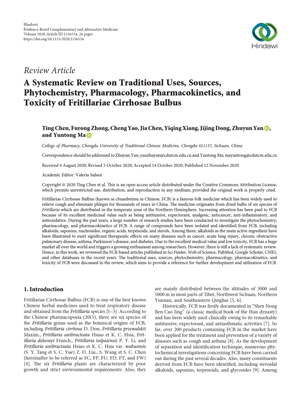NEWS 2020
A Systematic Review on Traditional Uses, Sources, Phytochemistry, Pharmacology, Pharmacokinetics, and Toxicity of Fritillariae Cirrhosae Bulbus
Ting CHEN, Furong ZHONG, Cheng YAO, Jia CHEN, Yiqing XIANG, Jijing DONG, Zhuyun YAN, Yuntong MA
Evidence-Based Complementary and Alternative Medicine (2020)
https://doi.org/10.1155/2020/1536534
College of Pharmacy, Chengdu University of Traditional Chinese Medicine, Chengdu 611137, Sichuan, China
Abstract
Fritillariae Cirrhosae Bulbus (known as chuanbeimu in Chinese, FCB) is a famous folk medicine which has been widely used to relieve cough and eliminate phlegm for thousands of years in China. The medicine originates from dried bulbs of six species of Fritillaria which are distributed in the temperate zone of the Northern Hemisphere. Increasing attention has been paid to FCB because of its excellent medicinal value such as being antitussive, expectorant, analgesic, anticancer, anti-inflammatory, and antioxidative. During the past years, a large number of research studies have been conducted to investigate the phytochemistry, pharmacology, and pharmacokinetics of FCB. A range of compounds have been isolated and identified from FCB, including alkaloids, saponins, nucleosides, organic acids, terpenoids, and sterols. Among them, alkaloids as the main active ingredient have been illustrated to exert significant therapeutic effects on many diseases such as cancer, acute lung injury, chronic obstructive pulmonary disease, asthma, Parkinson’s disease, and diabetes. Due to the excellent medical value and low toxicity, FCB has a huge market all over the world and triggers a growing enthusiasm among researchers. However, there is still a lack of systematic review. Hence, in this work, we reviewed the FCB-based articles published in Sci Finder, Web of Science, PubMed, Google Scholar, CNKI, and other databases in the recent years. The traditional uses, sources, phytochemistry, pharmacology, pharmacokinetics, and toxicity of FCB were discussed in the review, which aims to provide a reference for further development and utilization of FCB.




